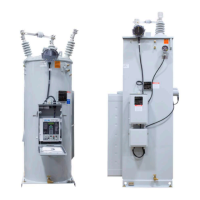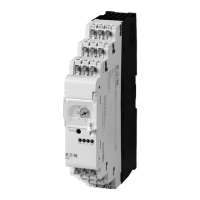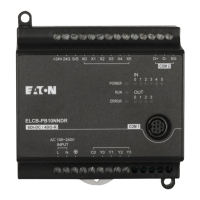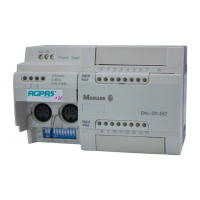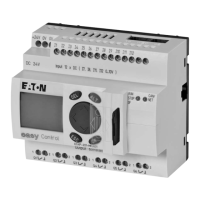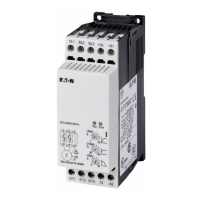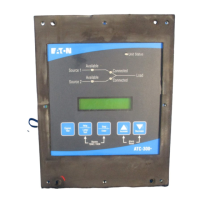16
Programming
EPCT FIRE SERIES FIRE PUMP CONTROLLER MN124016EN August 2019 www.eaton.com
5.6.9 Low foam shutdown
The controller can be programmed to shutdown when a
low foam condition is present. If this is desired, the user
will select Enabled. There will also be a shutdown delay
timer built in (Range: 0-99 Seconds, Default: 0 seconds)
along with the selection of either a Manual or Automatic
reset. If Manual Reset is selected, the “Press to Reset
All Conditions” in the notification area must be activated
to reset the alarm. If Automatic Reset is selected (default
reset mode), a delay timer (Range: 0-99 Seconds, Default:
0 Seconds) must be set. Once the input is closed, the
controller will start the Low Foam Delay timer. When the
timer expires, if the input for Low Foam is still closed, the
controller will shutdown the motor. When the input has
cleared, the controller will initiate the reset timer. After
the reset timer has elapsed, the controller will resume
automatic operation. All timers will be displayed in the
notification area. Low Foam Shutdown will have no affect on
Local Starts, Remote Manual Starts, or Emergency Starts.
ATTENTION
Nfpa 20 specifically prohibits the installation of any device
in the suction piping that will restrict starting or stopping
of the fire pump. Eaton assumes no liability when this
function is used.
5.6.10 Proof pressure switch
An external pressure switch can be activated on one of the
inputs. Enabling this feature requires that the programmed
input for Proof Pressure Switch is closed to allow the FPC
to start the motor.
5.6.11 Pressure units
The user can select which pressure unit of measure is to
be displayed. The units can be programmed for PSI, BAR,
or kPa.
5.6.12 Pressure transducer
Some applications do not require a pressure sensor to sense
the system pressure in order to start the pump motor when
required. In order to accomplish this, the pressure sensor
can be disabled through this menu item. Once disabled, the
pressure start point, pressure stop point, low pressure alarm,
and high pressure alarm set-points will be removed from the
menu system. Refer to 4.3 for the Remote Auto Start input
to use instead of the pressure sensor.
5.6.13 Calibrate transducer
The controller allows for three (3) different forms of calibration.
Full Calibration requires the system to be reduced to a
known value, typically 0 psi. This value is then entered into
the controller. The system pressure is then increased to a
higher known value which is also entered into the controller.
Calibrate Using Current Pressure is a partial calibration. The
low pressure point is assumed to be correct. The high point
is adjusted based on the actual system pressure.
Reset to Factory Default resets the transducer calibration to
the original factory settings.
5.7 Timer values tab
Refer to Appendix F for the menu structure of the Timer
Values tab
5.7.1 Minimum run time (RPT)
The minimum run timer is used to automatically stop the
controller after a programmed time. The timer will start
timing once the pump has reached a running condition. If
Automatic Shutdown is disabled, the RPT will not be active.
It will not start on Remote Manual Starts, Local Starts, and
Emergency Starts. While it is timing the amount of time left
on the timer will be displayed in the notification area.
5.7.2 Acceleration timer (AT)
The acceleration timer can be programmed to allow the
controller to run in a reduced voltage state for a period of
time. This timer will start timing once a start signal has been
received and the startup relay has energized.
5.7.3 Sequential start time
The sequential start timer can be set to delay the starting
of the pump when a automatic starting condition exists. If,
during the timing of the sequential timer, the pressure rises
above the pressure start point, the timer will stop timing
and the starting sequence will discontinue. When the SST
is timing, the time left will be displayed in the notification
area. The SST will not work on Remote Manual Starts, Local
Starts, and Emergency Starts.
5.7.4 Fail to start timer (FTS)
The controller determines that the motor is successfully
running when, at least, 20% of the programmed motor
full-load current has been reached. If the controller initiates
a start sequence, manual or automatic, and the calculated
current has not reached 20% of the motor full-load current
after the Fail To Start timer has timed out, the Fail to Start
alarm will be generated.
5.7.5 Fail to stop timer
The controller determines that the motor has successfully
stopped when the calculated current has dropped below
the 20% threshold after a call-to-stop was initiated. If the
controller initiates a stop sequence, manual or automatic,
and the calculated current has not dropped below 20% of
the motor full-load current after the Fail To Stop timer has
timed out, the Fail to Stop alarm will be generated.
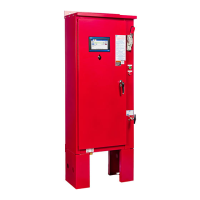
